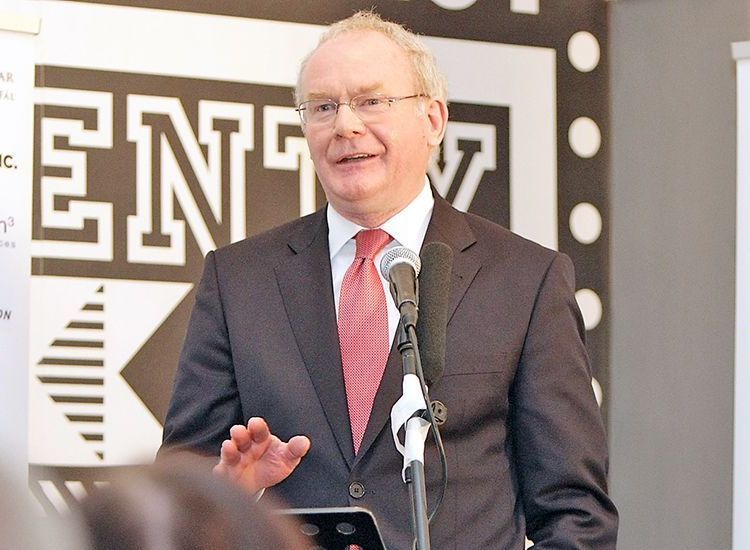By Peter McDermott
Bridget Cagney’s mother read to her every night when she was a small child. “Then when I learnt to read books and newspapers, and you had to learn quickly in those days, it was the greatest joy of my childhood,” said the Queens resident about growing up in County Cork. “And reading still is a great joy.”
Cagney buys the New York Times about every second day and all three of the Irish weeklies published in New York. “And Jim gets the Post,” she said of her husband, who emigrated with her in 1967.
The Cagneys don’t own or use a computer, which puts them in a minority now in the over-65 age group. Last year, the Pew Research Center for Internet and American Life announced that for the first time a majority of seniors (53 percent) use email or the Internet. But the Cagneys are part of the majority that doesn’t get news from any online source. Figures from Pew in 2010 revealed that just 38 percent of what it terms the “Silent Generation” (age 65 through 74) ever go to the Internet for news, whereas only 16 percent of the “G.I. Generation” (75 and over) do so.
Paul Finnegan, the executive director of the New York Irish Center in Long Island City, an organization that encourages seniors to acquire computer skills, said those figures are borne out by his experience. In an informal survey he conducted of those who attended the center’s Wednesday seniors’ lunch two weeks ago, 40 people said they preferred newspapers as a source of news, while five indicated TV and/or radio was best for them and four chose the Internet. “That TV/radio figure is a surprise,” Finnegan said. He wasn’t surprised, though, at those who voted for online news, all four being enthusiastic stalwarts of the center’s Saturday morning computer class.
Center regular Julia Anastasio, who sometimes goes online, is one of those who favors print media. “I get the Daily News every day and the Irish Echo every week,” said the County Offaly native. “The Irish Independent [Ireland’s largest-circulation daily] opens up on my computer. I sometimes go to the computer class and I’m getting better. I know how to Google.”
Anastasio’s favorite website is that of the Offaly-based Midland Radio 3, where she can read death notices and local sports news, as well as listen to music.
Even more enthusiastic computer users the Echo interviewed regard online sources as supplemental and not as a replacement for print media.
“I'm computer fluent,” said Neil Hickey, a journalist for more than 50 years. He subscribes, though, to the print editions of the New York Times, the Wall Street Journal and several periodicals.
“There are huge advantages to the digital revolution,” said Hickey, an adjunct professor at the Columbia University Graduate School of Journalism and a former editor-at-large for the Columbia Journalism Review. “I couldn't live without Google and e-mail. The whole world of information is at your fingertips.
“YouTube,” he added, “is a great joy and a phenomenal resource.”
But Hickey said: “I tell students that, for me, at least, reading news online is unsatisfying and insufficient to my needs.”
Three former teachers interviewed expressed contrasting positions about the Internet, but all, like Hickey, said that for them print news is primary. Patrick O’Sullivan, who spent his career teaching Spanish, was the most open of the three to the changes in the media landscape. “You could spend hours at the computer,” said the New Jersey resident, who has a second career as a realtor and follows the stock market as a hobby. “But I go online for what I can’t read in the New York Times and Barron’s.”
O’Sullivan buys the Times, he said, because the “writing is phenomenal.” He’s not so impressed with the news he sees online. “There’s no great beauty to it,” he said.
Joan Monsoury of Manhattan, who never uses a computer, is also a fan of the New York Times. “It’s a big part of my life,” she said. “And I listen to NPR and watch PBS. They’re all very satisfying.”
She doesn’t feel she’s missing out in any way and is “not motivated” to acquire a computer. “If anything happens, I hear about it several times a day,” Monsoury said.
Former English teacher Pat McGivern is someone who might be expected to take to the online experience more easily than others. She is a touch typist and worked with computers in the classroom before her retirement just over a decade ago. But, she doesn’t own one. Instead, she checks and responds to email at her local library on Long Island.
"Computers are a nuisance,” said McGivern, who still clips out newspaper articles to give to friends and family members.
One issue is her eyesight. Reading emails is a strain for her after a while. "I've been wearing glasses since 1943, since I was in the baby carriage," she said. That is not a problem when it comes to print. Lack of time is, however, as she is studying the Irish language at Lehman College.
"I buy the New York Times for arts at the weekend, but it's too much for me as a senior to read it all, and I subscribe to the Echo for music and arts and to know what's going on," McGivern said.
If the Times is too much, it is a case of not enough with other publications, which is indicative for her of the decline of print media. It led her recently to drop her subscription to Time magazine. “It's too dull and watered down,” she said. She had similar complaints about Long Island’s Catholic paper, which recently changed to a magazine format. "It's terrible," McGivern said. "There's nothing in it.
“We had very intellectual Catholic publications coming into the house in the 1950s. Now, they’re all very watered down. There’s not much in the way of theology,” she said.
McGivern also recalled fondly papers like the Journal American and the New York Herald Tribune, the demise of which in the 1960s was attributed in part to the rise of TV.
Maurice “Mickey” Carroll can speak to that issue. He was the Herald Tribune’s reporter in the basement of Dallas police headquarters when Lee Harvey Oswald was shot dead live on national television.
“There’s a lot of garbage passing around as news,” said Carroll, who began his newspaper career as a 14-year-old with the Rutherford (N.J.) Republican in the summer of 1945. “You’re getting blogs, opinion, amateurish stuff. It’s neatly printed. It looks the same.”
Referring to the economic viability of professional journalism, he said, “Fingers crossed, say a prayer, it will sort itself out.”
Carroll, who is the director of Quinnipiac University Polling Institute, worked for nine newspapers in all, including the Journal American and the New York Times. “You knew how to behave with facts. It was in your blood,” he said. “Even with new digital media, you hope that they will absorb the same standards.”
But the rise of cable news and the multiplicity of sources online means that people can cherry pick the evidence to suit their argument. “There was once an agreed set of facts,” Carroll said. The lack of one undermines the national conversation, he believes, and that has implications for older Americans.
“TV is a big trap for seniors, particularly male seniors,” McGivern said. “My friends in the Midwest are more liberal, but my friends in New York, some of them, listen to the guys who rant and rave.” She added that a member of her family believes that NPR is under the control of communists.
Some seniors interviewed felt that reading online was inherently superficial. Cagney said that when she was still in the workforce a decade ago many of her younger colleagues didn’t read beyond a story’s headline and a few paragraphs. “They weren’t getting the different sides of the story, it seemed to me,” she said.
Carroll said he “surfs the headlines” online. “Every now and then I look at Politico,” he said. But he believes that looking through a newspaper yields better results. “The serendipitous aspect,” he said. “That’s lost [online].
“I’ve got to have a newspaper in my hands. But that’s because I’m old,” Carroll said, with a laugh. His friend Francis X. Clines, a member of the New York Times’ editorial board, told him that he’s typically the only person in the elevator at work with the newspaper under his arm. “None of the kids have it,” he said.
For some seniors, it is more than a case of what they’re used to; it’s what they like.
“I love the feel of the paper,” said Cagney, who sets aside time, sometimes hours, to read at the end of the day. “I get a great sense of warmth when I look at headlines in Hudson News in Grand Central.
“I can’t imagine giving up the paper,” she said. “I deplore the day that we have to.”
This is the last of three stories done as part of a MetLife Foundation Journalists in Aging Fellowship, a project of New America Media and the Gerontological Society of America.








